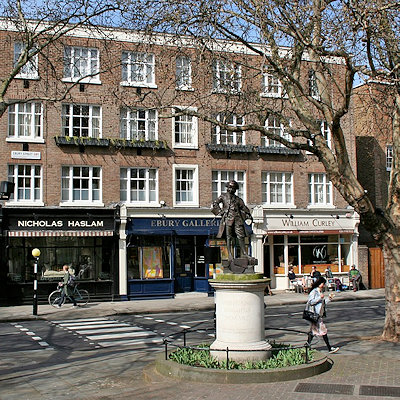
Like us on Facebook
PLACE NAMES


 
|
|
Pimlico
|

| |
Pimlico is a small area in the City of Westminster. Like Belgravia, to which it was built as a southern extension, Pimlico is known for its garden squares and Regency architecture.
The area is separated from Belgravia to the north by Victoria Railway Station, and bounded by the River Thames to the south, Vauxhall Bridge Road to the east and the former Grosvenor Canal to the west.
At Pimlico's heart is a grid of residential streets laid down by the planner Thomas Cubitt beginning in 1825, and now protected as the Pimlico Conservation Area. Pimlico is also home to the pre-World War II Dolphin Square development and the pioneering Churchill Gardens and Lillington and Longmoore Gardens estates, now designated conservation areas in their own right. The area has over 350 Grade II listed buildings and several Grade II* listed churches.
Notable residents have included politician Winston Churchill, designer Laura Ashley, philosopher Swami Vivekananda, actor Laurence Olivier, illustrator and author Aubrey Beardsley, first Kenyan president Jomo Kenyatta and the inventor of lawn tennis, Major Walter Wingfield.
In the sixteenth and seventeenth centuries, the Manor of Ebury was divided up and leased by the Crown to servants or favourites. In 1623, James I sold the freehold of Ebury and the land was sold on several more times, until it came into the hands of heiress Mary Davies in 1666.
Mary's dowry not only included "The Five Fields" of modern-day Pimlico and Belgravia, but also most of what is now Mayfair and Knightsbridge. Understandably, she was much pursued but in 1677, at the age of twelve, married Sir Thomas Grosvenor. The Grosvenors were a family of Norman descent long seated at Eaton Hall in Cheshire who until this auspicious marriage were but of local consequence in their native county of Cheshire. Through the development and good management of this land the Grosvenors acquired enormous wealth.
At some point in the late seventeenth or early eighteenth century, the area ceased to be known as Ebury or "The Five Fields" and gained the name by which it is now known. While its origins are disputed, it is "clearly of foreign derivation.... Gifford, in a note in his edition of Ben Jonson, tells us that 'Pimlico is sometimes spoken of as a person, and may not improbably have been the master of a house once famous for ale of a particular description." Supporting this etymology, Rev. Brewer describes the area as "a district of public gardens much frequented on holidays. According to tradition, it received its name from Ben Pimlico, famous for his nut-brown ale. His tea-gardens, however, were near Hoxton, and the road to them was termed Pimlico Path, so that what is now called Pimlico was so named from the popularity of the Hoxton resort".
H.G. Wells, in his novel The Dream, says that there was a wharf at Pimlico where ships from America docked and that the word Pimlico came with the trade and was the last word left alive of the Algonquin Indian language (Pamlico).
|
 Feel free to Email me any additions or corrections Feel free to Email me any additions or corrections
LINKS AVAILABLE TO YOUR SITE
| |





